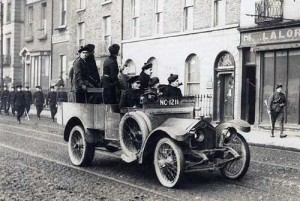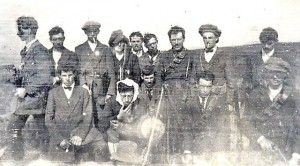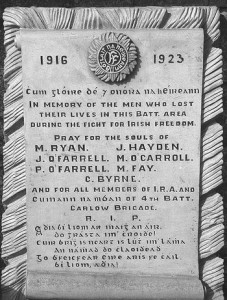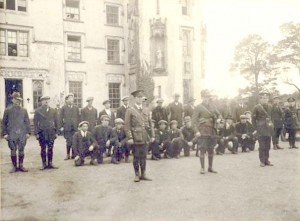Bushwhacked: The Loss of the Carlow Flying Column, April 1921

Daniel Murray on an IRA reverse during the Irish War of Independence
On the 21st of April 1921, Pádraig Kane, an adjutant in the Carlow IRA Brigade, received news of the worst kind and hurried to where the Brigade O/C Eamon Malone was staying.
Kane’s expression alone was enough for Malone, who had been settling down with a cup of tea, to ask: “What disaster has happened now?” It was an apt response to a catastrophic intelligence failure and a crushing defeat.[1]
The Carlow Brigade had struggled with the same difficulties that had beset many of the others throughout the country.
From its formation in 1917 and the triggering of the War of Independence in early 1919, the Carlow Brigade had struggled with the same difficulties that had beset many of the others throughout the country: maintaining manpower and morale against constant shortages of weapons and ammunition, while surviving the attentions of an entrenched British army and the increasingly militarised Royal Irish Constabulary (RIC).
The Brigade responded with a cautious approach, with planned operations cancelled at the first hint of unexpected difficulty. In June 1920, a three-man team from the Tullow Company was to meet up with their commanding officer before holding up the RIC in the nearby barracks, but when the officer failed to show, the attempt was called off.[2] Similarly, a proposed assault by several battalions on Bagenalstown Barracks in early 1921 was aborted when poor coordination and planning made the possibility of success unlikely.[3]
Crown forces adopted a wariness of their own: the men of the 1st battalion lay in ambush along the back road between Carlow town and Bagenalstown for an anticipated enemy patrol, but after hours of waiting the target never came.[4] Likewise, an attack planned by the 4th battalion in Borris in September 1920 was thwarted when the targeted RIC patrol broke its usual routine and did not come as expected.[5]
Forming the Column

It was to break this impasse that the flying column was formed as a small, dedicated body of men who would be well-armed and mobile enough to take the fight to the enemy.
As many of its members were already on the run, they would not have had to adjust their lives by much. Leading the column was Laurence O’Neill, a Tipperary émigré who had already held a number of ranks in the Carlow Brigade and was thus considered sufficiently experienced.
The newly established column began its training in the area near Killeshin, on the borders of Leix and Kilkenny. The hilly, uninviting terrain would help deter unwanted attention while the column based itself in an empty farmhouse, relying on local people for food.
The Carlow flying column was set up in late 1920, made of local men on the run from the British authorities.
It was at this time that a Black-and-Tan named James Duffy was shot at while leaving a pub in plainclothes and with a civilian companion, Harry James. Duffy was killed and James badly wounded. The assumption was that Duffy had been investigating the area with the other man as his guide and spy. It is unknown whether the men of the column had been the ones who had killed Duffy but, as they were residing nearby at the time, it is a strong possibility.[6]
Preparing the Column
The column had hoped to christen its campaign with an attack on Bagenalstown Barracks, which had only recently avoided an earlier assault without knowing it. The attack was to be in unison with men from the 4th battalion, with the 1st and 3rd battalions assisting in securing all roads to Bagenalstown in order to stave off any enemy reinforcements. As with many of the proposed operations by the Carlow Brigade, it was cancelled, this time due to the inopportune arrival of British reinforcements in Crossley lorries before the roads could be blocked, prompting the column and the battalions to prudently withdraw.[7]
According to Kane, the column planned another attack on Bagenalstown Barracks. But with the lack of explosives with which to breach its walls and in the absence of an expert to make them, the plan was yet again called off, making Bagenalstown one of the luckiest barracks in the War. However, it is uncertain as to whether Kane was confusing this foiled attempt in his Statement with the one above.[8]
The column moved north to the townland of Mullinagown on the 19th of April, in the territory of the 4th battalion of the Carlow Brigade, where it billeted in an unoccupied house. From there, the column intended to join up with its North Wexford counterpart, then in the neighbouring Blackstairs Mountains, and sent two scouts ahead to make contact, but fog made that task impossible and ensured that the column would remain by itself.[9]
Losing the Column
 What happened two days later was headlined in The Carlow Nationalist as: ENGAGEMENT IN CO. CARLOW – FIVE STATED TO BE KILLED. Quoting a report from the British military GHQ:
What happened two days later was headlined in The Carlow Nationalist as: ENGAGEMENT IN CO. CARLOW – FIVE STATED TO BE KILLED. Quoting a report from the British military GHQ:
A patrol of Crown forces surprised an armed party of civilians drilling near Ballymurphy, County Carlow, on Monday evening. An engagement ensued resulting in some (believed to be five) of the rebels being killed, two wounded and six captured.
Eleven rifles, one shot-gun, several revolvers, a quantity of rifle and dun-dun ammunition.
The Crown forces suffered no causalities.[10]
In fact, four had been killed. One member of the aforementioned armed party, Michael Fay, had previously served in the British army for three and a half years, as part of which he had seen action in the trenches of France. He had lived with his parents in Rathvilly, Co Carlow, for some years after moving there from Dublin, and was described by the article as “very popular in the district.” His funeral was to receive a considerable turnout by Volunteers, Cumann na mBan and ex-servicemen, and in keeping with the diverse range of people Fay had known, his tricolour-draped coffin was born by both Volunteers and ex-servicemen.
In April 1921 the Carlow column was all but wiped out in an engagement at Ballymurphy, with four killed and eight captured.
Fay was the only one of the dead who had been definitely connected with the day’s fighting. Of the other three, all unnamed in the article, one had been an old man of sixty-two. It was unknown if the remaining two had been with the armed party, but they had been running with them at the time of their deaths.
On a seemingly unrelated note, another article in the newspaper was titled: SHOCKING AFFAIR NEAR MOUNTRATH – YOUNG MAN SHOT DEAD – ROBBERY THE ALLEGED MOTIVE. It was not a story that was obviously related to that of the previously described engagement, and was treated by the Nationalist as entirely separate. Only decades later would there be a direct connection made between the two.[11]
The Court-Martial of the Column
It would not be until July, over two months later, that the court-martial for the prisoners took place. Held in the Curragh, it centred on the testimony of an (unnamed by the attending Nationalist reporter) British officer who had been leading the Crown forces in the capture of the column. It is the only first-hand account of what happened. As it was tailored to be heard in court, it is far from a complete source, but it does provide a solid, step-by-step version of events.
The eight men in the dock were facing six separate charges relating to possession and use of illegal firearms, and so the testimony at the court-martial took the time to focus on details such as when the suspects were believed to have opened fire, the number of weapons found on the scene, the state of the guns as to whether or not they had been recently fired, and other points relating to the charges.[12]
Unfortunately, no surviving member of the column submitted a Statement to the BMH, depriving historians of an insider’s perspective. The closest we have are the BMH Statements of Pádraig Kane and Thomas Ryan, an intelligence officer in the 4th battalion, which flesh out a number of details. Neither was present at the scene, and both were presumably reliant on hearing about it from the survivors afterwards.
The 8 captured IRA men were tried by court martial at the military base at the Curragh.
However, the two of them match each other and the court-martial account in such details as the column being surprised as it was drilling in a field. Incredibly, no one in the column had thought to post sentries. Historian William Nolan felt the need to offer “extenuating circumstances for their apparent negligence,” in that the column men had been anticipating the arrival of a GHQ representative “and could reasonably expect the whole area to be on the alert.” Reasonably or otherwise, the column members were to be very much mistaken in their complacency.[13]
The Fight of the Column

The Crown force consisted of six soldiers and seven Black-and-Tans along with two officers, one senior and the other junior. Driving in on the scene on two Crossley lorries, the patrol rapidly disembarked and opened fire on the Volunteers, about 200-250 yards away, who fled without returning fire.
The Crown forces gave chase in two squads and, after 100 yards, the squad with the lead officer spotted the column men moving along a hedge, presumably for the cover, and opened fire again. The lead squad advanced up a laneway where they re-joined the other group, catching sight of the suspects from time to time who were making no attempt at that stage to shoot back.
Upon reaching a certain point, the senior officer saw the IRA men split into two groups moving in opposite directions, at which point the Crown forces followed suit and continued the chase, one squad for each half of the column. The lead British squad opened fire again, and the officer was sure that the suspects were returning fire this time, for he “could hear the crack of rifles which [he] knew did not come from behind [him].”
From the court martial evidence and statements given by IRA veterans to the Bureau of Military History, it is possible to put together what happened at the Ballymurphy ambush.
Emboldened by the poor aim of the enemy, the lead squad pressed on, coming across four of the suspects – Patrick Gaffney, Patrick Fitzpatrick, James and Michael Behan – lying on the ground with their hands up, their rifles discarded nearby, with two more men – Laurence O’Neill and Thomas Behan – in a similar position of submission. Upon taking these six men prisoner, the squad met up with the other, who had two prisoners of their own: Michael Ryan and William McKenna.
Two other column members, William Gaffney and a Fitzpatrick (first name unstated) were able to escape in the confusion, making the total number of the column at the time of its loss to have been eleven men: eight captured, two escaped and one killed.[14]
The captives were transported under guard to Borris Barracks on the Crossleys where O’Neill and McKenna received treatment for their injuries. The victorious patrol then returned to the scene of the fight and uncovered a number of rifles, Webley pistols and shotguns with their accompanying ammunition in the house next to the field where the suspects had been found drilling. Explosive substances and an unexploded bomb were also found in the house. Clearly, the column had been hoping to make up for its past failed attempt on Bagenalstown Barracks.
Michael Fay
Three dead men were found on the scene, according to the officer’s testimony, two in a house and the other in a field, the latter identified in court as Michael Fay. He had been killed by shotgun wounds, according to an earlier Court of Inquiries, though Thomas Ryan was to describe in his BMH Statement that Fay had been bayoneted to death while on the ground, already wounded from gunshots, so that “several parts of his hands and his teeth were scatted round.”[15]
This was to become a sensitive point for the senior officer under testimony, with him denying that he had seen any bayonet wounds on Fay’s body, either at the scene or afterwards, upon being asked about it by the counsel for the defence, A. Wood. Sensing an opening, Wood pressed the officer over whether the wounds on Fay’s arm were caused by gunshots or a bayonet, with the officer maintaining the former.
When it was his turn to testify, the junior officer denied seeing how Fay died, only that the squad under his command had found Fay when he was already dead, the implication being that he had been killed at a distance in the firefight, and not up close while already wounded as Wood was clearly implying.
Counting the Dead
Of the three other fatalities, none were mentioned at the court-material, presumably because their deaths were not relevant to the trial of the accused. According to Thomas Ryan, two of the dead had been brothers, James and Peter Farrell, and both had been shot and bayoneted near where the column had been overwhelmed. In Ryan’s version, they were sowing corn in their field when the fight began, and had been attempting to reach the column in order to warn them – to Ryan, that was the only explanation, as they would have had no other reason to go in that direction, it being opposite from their home. According to Pádraig Kane, both brothers had no relation to the fight and were innocent victims of circumstances.[16]
It is alleged that 4 men killed by British forces were bayoneted or shot while wounded. In addition three of the dead killed in this way were mere civilian bystanders.
In either case, there was no question as to the harmlessness of the third bystander, identified by Thomas Ryan as 62-year-old Michael Ryan (no relation, presumably). According to Thomas Ryan, Michael’s son John was a Volunteer who was leaving home with IRA dispatches to his company captain when he was chanced upon by one of the patrol squads, which opened fire and forced him back in. Ignoring his son’s warning to stay inside, Michael Ryan went out for a bucket of water and was found dead by John at the pump with a bullet-wound to the face.[17]
It is unclear as to whether the Farrell brothers and Michael Ryan were killed by stray shots or deliberately gunned down, perhaps mistaken for members of the fleeing column, whose lack of uniforms would have made unlucky civilians indistinguishable from combatants. In any case, the testimonies of the two officers at the court-martial, which strove to portray the conduct of themselves and their men as models of cool, dispassionate efficiency, only told part of the story.
The Fall-Out from the Column
Two days after the disaster of the column, on the 23rd of April 1921, Michael Byrne, a man in his early 30s, was shot to death while returning home from visiting neighbours. The best motive that could be guessed at for anyone wanting harm on a member of a “very popular” farming family was robbery, as he had recently come into possession of £100 and was known to have kept the money on him.[18]
A local man, Michael Byrne, was killed shortly after the ambush, probably as a suspected informer in the wake of the ambush.
Writing over thirty decades later, both Pádraig Kane and Thomas Ryan told of the death of a spy they had blamed for exposing the column to ambush and defeat. In Ryan’s BMH Statement, his name had been Finn, and he had led the British patrol to the site of the Column. Finn had disappeared shortly afterwards and, after initial failed attempts to find him by the IRA, had been captured and taken to an old house. From there he had escaped, and was heading for the safety of Borris Barracks when he was caught again and finally executed after an improvised trial. A large amount of money was said to have been found on him, presumably the reward for his spying.[19]
Kane’s version is broadly similar, in that a spy had guided the British to the column, and afterwards had been captured and detained near Borris. It diverges from Ryan’s in that there had been no escape or second arrest, the spy’s name is not given, and in how the spy had been shot dead while trying to overcome his guard as opposed to executed. Strikingly, Kane gives the value of the money found on the dead man as £100, the same amount the Nationalist reported as being in the possession of Michael Byrne.[20]
It is possible, then, that Byrne was killed on the 23rd of April 1921 as a result of being suspected as the spy who had doomed the column. There are a number of problems with that theory, however:
- Ryan got Byrne’s name wrong, unless ‘Finn’ was a nickname.
- The two days in between the wipe-out of the column and Byrne’s death seems rather brief to fit in the drawn-out tale of capture, escape, recapture, trial and execution that Ryan offers.
- That Byrne was on route from a social call to neighbours would indicate he did not drop out of sight immediately, as Ryan described, after the column’s loss.
Kane’s briefer account fits better into what it is already known from the Nationalist, though his description of spies travelling the countryside while dressed as tramps seems overly outlandish, considering how Byrne was a local man and presumably would have needed no excuse to be in the area. Neither Ryan nor Kane give a reason as to why Byrne would have been suspected so quickly after the column’s end, despite both being well placed to have known, given Ryan’s rank as a battalion intelligence officer, and Kane’s work as an IRA mole in the Carlow town post office amongst the hub of police reports and official mail.
The exact circumstances over Byrne’s death must thus remain a mystery. He may have been a spy, or suspected as one at a volatile time for the Carlow IRA. Or his death could have been over a robbery as originally reported, with Kane and Ryan confusing a death from decades ago as a causality of their war by the time they gave their Statements.
Conclusion
Due to a spirited defence by A. Wood, the eight men from the column were found not guilty at their court-martial of the first two charges arrayed against them: endangering the safety of Crown personnel by the discharge of firearms, and the aiding of such an act. The other four charges, all relating to the owning of contraband such as guns and explosives, were to be announced later. According to Kane, the prisoners ended up receiving lengthy prison time, though the forthcoming Truce would nullify all such sentences. The erstwhile column leader, Laurence O’Neill, would go on to marry the former fiance of Dick McKee, the slain Dublin Brigade commandant, and raise a family.[21]
The 8 captured IRA men were found not guilty at their court martial of ‘endangering the safety of Crown personnel by the discharge of firearms’. Nevertheless, it was the end of the Carlow Flying Column.
Kane would recall Brigade O/C Eamon Malone’s distress was primarily for the loss of the weapons rather than the men in the column. Kane was not unsympathetic – he, too, agreed with Malone’s assessment that the Carlow Brigade had the personnel to spare but not the equipment, certainly not enough for any successor column. There would be no further attempts at a flying column for the duration of the War.[22]
That the column had been crushed so effectively with no loss to the enemy, despite the two sides being roughly even in numbers and weapons, inadvertently justified the cautious approach taken by the Brigade battalions. The unspoken view had been that head-on confrontations with the British army or RIC would invite disaster, and there could be no better illustration of this than how the Carlow Brigade risked much in forming a column and lost accordingly.
Bibliography
Bureau of Military History / Witness Statements
Byrne, Daniel,WS 1440
Doorley, Michael, WS 1509
Hynes, John, WS 1496
Kane, Pádraig, WS 1572
Ryan, Thomas, WS 1442
Article
Nolan, William, ‘Events in Carlow 1920-21’, Capuchin Annual 1970
Newspapers
The Carlow Nationalist, 23/04/1921
The Carlow Nationalist, 09/07/1921
Online Article
Hogan, Louise (17/05/2012) ‘Relatives wear 1916 medals with pride at Arbour Hill,’ The Irish Independent, http://www.independent.ie/irish-news/relatives-wear-1916-medals-with-pride-at-arbour-hill-26854278.html (Accessed 03/08/2014)
[1]Kane, Pádraig (BMH / WS 1572), pp. 17-8
[2]Byrne, Daniel(BMH / WS 1440), p.2
[3]Kane, pp. 13-4
[4]Doorley, Michael (BMH / WS 1509), p. 4
[5]Ryan, Thomas (BMH / WS 1442), p. 9
[6]Kane, p. 16
[7]Doorley, pp. 4-5 ; Hynes, pp. 15-16
[8]Kane, p. 17
[9]Ibid, pp. 16-8 ; Ryan, pp. 7-8
[10]The Carlow Nationalist, 23/04/1921
[11]Ibid
[12]Ibid, 09/07/1921
[13]Nolan, William, ‘Events in Carlow 1920-21’, Capuchin Annual 1970, p. 587
[14]Ryan, p. 11
[15]Ibid, p. 8
[16]Ibid ; Kane, p. 17
[17]Ryan, p. 7
[18]The Carlow Nationalist, 23/05/1921
[19]Ryan, p. 9
[20]Kane, p. 18
[21]Hogan, Louise (17/05/2012) ‘Relatives wear 1916 medals with pride at Arbour Hill,’ The Irish Independent, http://www.independent.ie/irish-news/relatives-wear-1916-medals-with-pride-at-arbour-hill-26854278.html (Accessed 03/08/2014)
[22]Kane, pp. 17-18